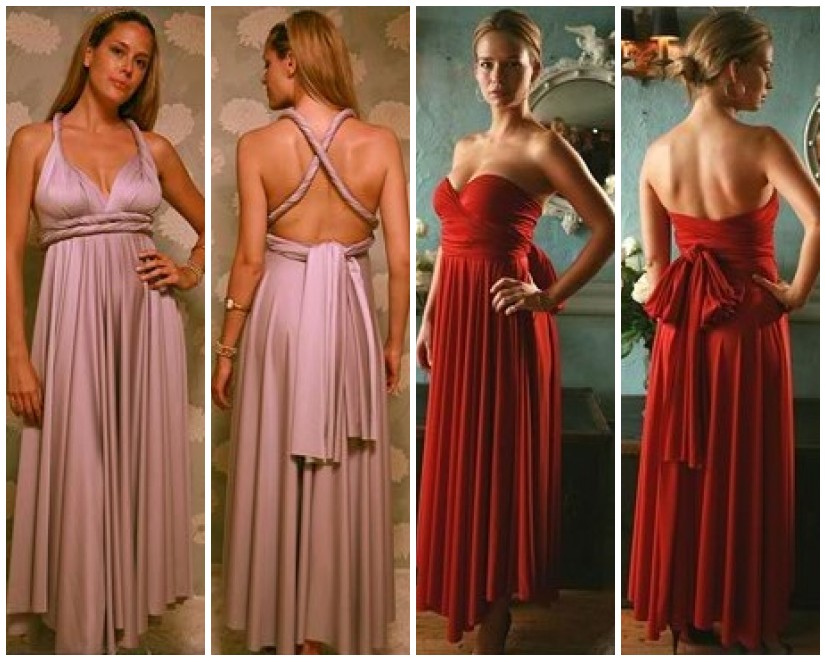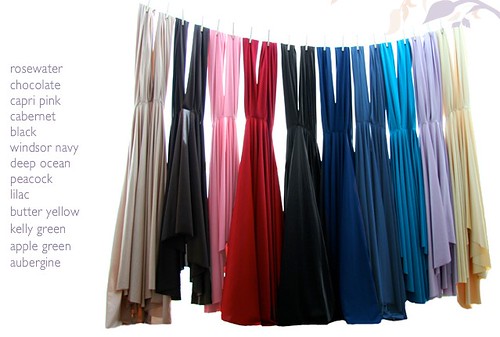The Star, Tuesday July 28, 2009
Keeping traditional wedding alive
Modern one-stop wedding shops serve to keep old Chinese customs alive.
RED is regarded an auspicious colour for weddings but you’d be hardpressed to find Chinese couples dressed in the traditional red kwa (Chinese wedding attire) these days.
Many young Chinese couples have done away with old customs such as distributing pre-wedding gifts like ka lui pang (wedding biscuits) and the roasted suckling pig. At the wedding reception, many of the guests may be dressed in elegant little black dresses. The venue will more likely be a five-star hotel or even a garden party rather than a crowded and noisy Chinese restaurant.
At most, just to please the old folks, a tea ceremony would be held. In fact, much of the wedding paraphernalia and practices are passed down the generations, and along the way, much of the significance of why they exist in the first place, are forgotten.Old custom: A traditional Chinese wedding requires a lot of effort and planning.
If you want to follow the old ways, a traditional Chinese wedding begins weeks before the actual day, from the meeting of the in-laws to the exchange of customary gifts, as well as the rituals to be followed leading up to the eve and on the wedding day, along with all the accessories that must be bought in preparation for the wedding.
It takes a lot of effort and planning, which may explain why some couples choose to do away with old customs. For those who want to adhere to tradition, there are shops like those along Petaling Street or Jalan Ipoh in Kuala Lumpur, for example, which stock up on Chinese wedding products. Unfortunately, not many of the shop operators are able to explain why such items are necessary.
It can also be an exhausting affair, traipsing from shop to shop to find the appropriate items. Some shops, however, have evolved with the times, becoming one-stop centres that provide wedding planning services, along with all the colourful red paraphernalia, in comfortable air-conditioned settings.Winnie Wong showing life-size wooden red clogs and miniature clogs which are symbolic gifts during a Chinese wedding.
One such outlet is Cadeau Souvenirs located at The Atria Shopping Centre in Petaling Jaya, Selangor. Opened last December, the shop offers knick-knacks such as red paper cuttings, ang pows, keychain clogs, pillows and bedsheets, ceramic wedding dolls, gift baskets, and even incense paper and jossticks for ancestral worship.
What’s more encouraging is that proprietor Winnie Wong, an ex-wedding planner, is thoroughly familiar with Chinese customs and can explain the significance of the individual items. This way, you can decide for yourself what’s necessary and what should be relegated to the backwaters of history.
On the day of this interview, a Chinese woman walked in, desperate for Wong’s advice.
“My son is getting married to a Malay girl tomorrow and I need to buy prayer items to thank the house gods,” she confided in Wong. She left a satisfied customer as she got what she wanted, relieved that her last minute shopping was done.A blushing bride arriving in a sedan chair. Such wedding dolls are favoured as a decorative item for the bridal chamber.
Two hours later, two women arrived with a little boy in tow.
“I’m accompanying my prospective daughter-in-law who is making early wedding plans because her parents are in Sarikei (Sarawak),” explained housewife Chan Yoke Pau, 57.
Music teacher Annie Wong, 28, had planned to get married during the school holidays but Chinese restaurants are fully booked up to this October. Hence, she set a date for next January.
The women enquired about tea sets and other necessary items including the red doorway cloth.
Chan admitted that she had forgotten what was required for a wedding. She wanted to keep the rites simple but was keen about observing certain rites.A pair of ‘symbolic’ poultry to replace the live chicken usually given in a Chinese wedding.
“My mother-in-law broke a tea cup from a new tea set without my knowledge. To avoid any inauspicious implications, she replaced it with an entirely new tea set before the wedding. Later, I found parts of a broken tea cup under my bed,” recalled an amused Chan.
Wong explained that most wedding items should be provided by the bride since she gets a dowry. The tea set (char kwai) is a wedding must-have.
“It signifies that the bride is bringing luck into the groom’s household. Customarily, the tea ceremony is held to pay respects to the elders and has a connotation of water or sui which the Chinese take to mean luck,” she says.
Next comes a pair of bowls (yee sik woon in Cantonese) complete with spoons and chopsticks. This symbolises “a good livelihood” for the groom. Bowls with peony flowers, mandarin ducks or dragon and phoenix are popular choices. Annie also asked about gifts for the groom and was told to buy the red doorway banner, dragon-phoenix candles and 36 fruits.
“As your in-laws are outstation, it would be better to get the fruits in Sarawak closer to the day. Buy any seasonal fruits except the pear as the Chinese homonyn for pear, lei, is associated with divorce (lei fun),” advises Wong.
“For the roast pig and a pair of live chickens, you can substitute these with ang pow packets for the bride’s family so that they can buy these gifts themselves rather than lug them on the plane.”
Wong sells special ang pow packets with Chinese characters to denote what the token money is for, such as roast pig, poultry, wine and other gifts.
Wherever possible, she tries to convince young couples to uphold traditions.
During traditional Chinese weddings, the table lamp for the bridal chamber is also deemed compulsory. In the past, a kerosene lamp was used and it had to be kept continuously lit for three days and three nights. The flame is kept alive in the wish that this year is the wedding feast (hei chow) and next year, would be the full moon celebration (moon yit chow). The household is also kept brightly lit to activate the flow of qi (energy) for auspiciousness.
These days, however, modern couples can buy electrical table lamps for the bridal room to avoid possibly causing a fire.
Red wooden clogs were also very much a part of Chinese wedding paraphernalia as they were accompanied with the phrase poh poh koh sing (Cantonese, which translates loosely as “may every step be accompanied by prosperity”). Nowadays, these are represented in the form of keychain clogs or even fridge magnets, which are no more than clever marketing ploys to implore the young to observe old customs. Some miniature clogs even come with zodiac signs of the newlyweds. Some traditional Chinese parents insist on giving the Offspring Bucket (chee sin toong in Cantonese which comprises basin, mug, spitoon, tea tray and baby’s bathtub) as it symbolises blessing the couple with children.
“My sister refused the Offspring Bucket during her marriage. Now in her 40s, she is still childless,” related a housewife in her 50s.
Other practices include sprinkling dried fruits and nuts on the bridal bed to bless the happy couple with many children and grandchildren.
The modern variation offers small pouches of prepacked fruits and nuts for this purpose, saving you the trouble of going to the dried foodstuff or sundry shop. Even live chickens (tai loh kai) can be substituted with a pair of fake ones!
In the past, a pair of chickens would be placed under the bridal bed. Then, every effort is being made to scare the chickens out. If the rooster comes out from under the bed, then a male offspring is predicted for the married couple. So far, no one can verify the accuracy of this prediction and plastic chickens won’t be much help in this department!
Traditionalists may insist on a “hairdressing ceremony” (seong tao), regarded as “a rite of passage” prior to the nuptial. This is usually carried out at midnight on the eve of the wedding by a woman (who has a living spouse) who has a happy family to denote auspiciousness.
Items for the ceremony include a ruler, a bunch of red threads and a mirror (plus a handkerchief for the bride’s side). The woman who combs the bride or bridegroom’s hair can also be his or her own mother (or any elder), if she fits the bill.
If the groom-to-be observes a hairdressing ceremony on the wedding day (after midnight), the bride-to-be must also perform this rite. If he chooses not to have this ceremony, the couple will drop this ceremony entirely.
The ritual marks the passing of a child into adulthood and is regarded as a must as it is symbolic of “offering prayers to Heaven, Earth and Mankind to ask for blessings for a lasting marriage.” Even so, such prayers are no guarantee that the marriage will last.
Many age old customs are no longer em-ployed in today’s modern Chinese weddings and Wong’s enterprise is one way to keep these practices alive. Even though many of the products offered in one-stop shops like hers seem like marketing gimmicks more than anything else, at least it’s one avenue where the next generation can incorporate old world customs into modern weddings.
http://thestar.com.my/lifestyle/story.asp?file=/2009/7/28/lifeliving/4149004&sec=lifeliving
The Star, Tuesday July 28, 2009
Wedding taboos
By MAJORIE CHIEW
IN Western society, June weddings are popular. The practice was believed to be influenced by the Romans who favoured weddings on that month. Apparently, the month of June was dedicated to the observance of Juno, the Roman goddess of marriage.
Traditional Chinese on the other hand, don’t like holding weddings on the sixth lunar month because they believe that such weddings will not last. An old Chinese adage says that such marriage equates to “a half-year marriage” (poon nin chai in Cantonese).
Two other taboo months are the seventh lunar month (the Ghost Month) and the fourth lunar month (Qing Ming). Weddings are avoided during these inauspicious months owing to the belief of spirits roaming the earth.
During a wedding, the Chinese also have many superstitions and taboo practices.
According to Winnie Wong, proprietor of Cadeau Souvenirs, guests are not allowed to use hand fans on a hot day. It is taboo because it signifies the separation of the couple.
After the wedding banquet, it is taboo to say the words “see you again” to the newly-weds, as this would imply a second marriage.
On the wedding day, the bride is prohibited from wearing a dress with pockets as some Chinese deem it as “siphoning out the wealth luck from the bride’s home”.
When a wedding car passes another wedding car, it is said that both the new couple’s bliss can be eliminated. To save the situation, the tai kum chea (bridal chaperone) must promptly announce: “Nothing is taboo.”
When the bride enters the bridegroom’s house, she must not step on the threshold but walk across it. The bride should not to step on the bridegroom’s shoe as it signifies humiliating him.
Within the first four months after the wedding, the newly-weds are not allowed to attend any weddings and funerals. These days, the wedding couple is not supposed to attending such functions one month before and one month after their nuptial to avoid courting bad luck.
http://thestar.com.my/lifestyle/story.asp?file=/2009/7/28/lifeliving/4149004&sec=lifeliving
Article and photo credit: The Star











